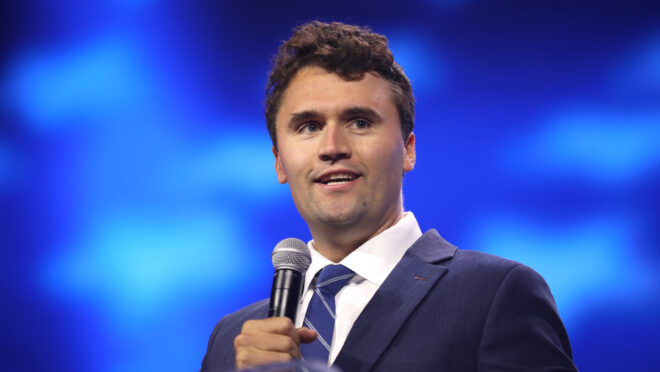A newly leaked audio, released alongside the original 911 call, reveals never-before-heard developments from Charlie Kirk’s final moments. Listening once will make you want to hear it again, as every chilling detail is laid bare.
A newly leaked audio, released alongside the original 911 call, has thrown the entire nation into disbelief. This is not just another snippet of a distressing moment—it is the raw, unedited account of Charlie Kirk’s final seconds, revealing details that were never meant to reach the public. Listeners describe the recording as “haunting,” “unsettling,” and “impossible to forget.” Within hours of going online, social media exploded, with millions scrambling to listen, share, and speculate.
What makes this audio so shocking isn’t just the fact that it exists—it’s what it contains. Every pause, every gasp, every shudder of fear is preserved in chilling detail. The official narrative, long presented by authorities, is crumbling under the weight of these revelations. Experts, journalists, and ordinary viewers alike are questioning everything they thought they knew about what happened that night.
A Nation in Shock
Across social media platforms, hashtags like #CharlieKirk911, #TheAudioTruth, and #HiddenMoments began trending within minutes. On Twitter, thousands of users reported feeling “frozen” after hearing the clip, while others admitted they couldn’t listen all the way through. “I tried listening once, and I couldn’t finish,” one user wrote. “It’s like being inside the room, feeling every second of terror.”
The recording begins with the caller’s panicked voice, immediately signaling that something far worse than reported had occurred. The tone, cadence, and urgency are inconsistent with the calm, sanitized account the public had been given. Professionals who reviewed the clip privately told our reporters that the audio indicates multiple unforeseen events unfolded, events that had never been disclosed in official statements.

Experts Speak Out
Dr. Michael Stanton, a forensic audio expert, told us:
"The timing, inflection, and emotional cues in this audio do not match the official report. There are multiple subtle indicators of something far more complex happening on the scene—something that was likely hidden from investigators and the public alike."
Similarly, a retired paramedic, who wished to remain anonymous, said:
"I’ve been on countless emergency calls. I have never heard a 911 call that carries this much fear and uncertainty. It’s raw, real, and horrifying. You can feel the panic through the recording itself."
Even mainstream media outlets that had previously reported the official story are now hesitating, unsure how to address this new evidence without contradicting previous reports.

The Moment Everyone is Talking About
Listeners repeatedly highlight a single sequence in the audio: the final seconds before Charlie Kirk loses consciousness. “It’s almost cinematic in its horror,” said one forensic analyst. “You hear the uncertainty, the panic in real-time. It’s not staged. This is reality, and it’s terrifying.”
Social media users have created thousands of threads dissecting every word, every sound, every pause. From Reddit forums to Facebook groups, people are debating what they heard, trying to reconstruct the event minute by minute. Many suggest that the official account missed—or intentionally omitted—critical moments that could change public perception entirely.
Leaked Documents and Mysterious Silence
Compounding the shock is the revelation that internal documents, recently leaked to independent journalists, corroborate the audio’s discrepancies. According to these documents, first responders reported certain irregularities on the scene that were never made public. The documents, combined with the audio, suggest there may have been multiple overlooked or deliberately concealed factors that contributed to the tragedy.
Authorities, meanwhile, have been silent. Requests for comment from local law enforcement went unanswered, fueling public suspicion. Why has this audio surfaced now? What took so long for these moments to reach the public? People are demanding answers.

Social Media Reactions: From Shock to Outrage
As soon as the audio hit the internet, reaction videos started flooding TikTok, Instagram reels, and YouTube. Millions of users shared their disbelief, often cutting between their horrified reactions and clips from previous coverage that had painted a different picture. Twitter exploded with threads analyzing the tone, the pacing, and the background noises in the recording.
Influencers in the true-crime space, political commentators, and conspiracy theorists all weighed in. Some suggested that the new audio could implicate previously unidentified individuals. Others focused on the apparent inconsistencies between what was recorded and the official narrative. A common refrain among viewers:
“Everything we thought we knew is wrong.”
The Human Side of the Story
Beyond speculation and theory, the audio also highlights the human tragedy at the center of this event. Family members, friends, and bystanders who listened have spoken about the emotional toll. Tears, whispered prayers, and stunned silence are common reactions, reflecting just how raw and intimate the recording feels.
Could This Change the Case Forever?
Legal experts say the audio could have enormous implications if verified as authentic. “If this recording contradicts official reports, it opens the door to reopening investigations,” said attorney Rachel Martinez. “We could be looking at a scenario where key witnesses need to be re-interviewed, evidence reexamined, and conclusions revisited. The public has a right to the full truth, and this could finally bring it to light.”
Some argue that the release of this audio is a turning point, not just for this case, but for public trust in official narratives in general. Social media’s viral response demonstrates that millions of people feel invested in uncovering the truth.

Questions That Demand Answers
What really happened in those final moments? Why was so much of the truth hidden from the public? Were there other individuals involved, or crucial details ignored? How did the initial reports diverge so dramatically from what the audio reveals?
Experts urge caution but also transparency. “We cannot ignore what we hear in this recording,” Dr. Stanton said. “It is a crucial piece of the puzzle, and it demands scrutiny from professionals, the media, and the public.”
The Aftermath and Global Attention
The leaked audio has not only shaken local communities but has also attracted attention worldwide. International news outlets have picked up the story, describing it as “unsettling” and “revealing.” For a few days, the name Charlie Kirk dominated trending topics on multiple continents.
Political commentators, entertainers, and journalists have all weighed in. Some have suggested that this could spark legislative or policy discussions about transparency in crisis reporting. Others have focused on the ethical questions surrounding the leak itself: should such raw, distressing material be released to the public? Or does the public have a right to hear it, no matter how painful?
Why This Matters
Beyond the shock value, the audio highlights deeper issues of trust, transparency, and accountability. It forces society to ask uncomfortable questions: how much of what we see and hear can we believe? And how often are the “official” stories incomplete—or even misleading?
In the case of Charlie Kirk, this recording may represent the clearest glimpse yet into the reality behind the tragedy. It’s a reminder that the truth can sometimes be stranger, more complex, and more harrowing than anyone could imagine.
A Call for Investigation
Independent journalists and advocacy groups are now calling for a formal inquiry. They argue that the audio, combined with corroborating internal documents, should be treated as compelling evidence. “We cannot allow this to be swept under the rug,” said investigative journalist Linda Chen. “There are too many unanswered questions. Too many voices silenced. The public deserves the full account.”
Conclusion
The release of this audio is more than just another news item. It’s a cultural moment, a turning point, and a challenge to every narrative we’ve been given. For millions, it is a reminder that truth is often complicated, painful, and inconvenient—but that does not make it any less necessary.
As viewers continue to listen, share, and analyze, one fact becomes increasingly clear: the story of Charlie Kirk is far from over. And until every question is answered, the nation—and indeed the world—will remain captivated, horrified, and demanding more.
The Questions No One Can Escape
As the leaked audio continues to spread at breakneck speed, a new wave of discussions has begun to dominate the national conversation—questions that cut to the bone of public trust, and that no official statement has yet dared to confront. Even those who previously dismissed the event as an unfortunate but straightforward tragedy now admit the audio has opened a door that cannot be closed.
Every second of the recording feels like a riddle wrapped in panic. Analysts describe the atmosphere as “thick with hidden meaning,” suggesting that background noises—once dismissed as irrelevant—might hold clues of their own. A faint metallic echo, a muffled impact, a distant voice that seems out of place… these subtle audio artifacts have become the center of massive online investigations.
What once seemed simple has become impossibly complex.
What was once declared “settled” is now anything but.
The Rise of the Citizen Investigators
With authorities silent and media outlets hesitant, everyday citizens have taken the lead. Digital sleuths on platforms like Reddit, X, and specialized true-crime forums have formed ad-hoc investigative teams, combing through every millisecond of the audio with analytical precision.
Some users have even used open-source sound-engineering tools to isolate frequencies and amplify faint background cues. One popular thread claims that a distorted voice, barely audible beneath the caller’s panic, says something that contradicts the original timeline entirely.
Another group of listeners suggested the presence of a second individual in the room, noting a shadowy pattern of overlapping breaths—too controlled, too measured to belong to the caller. Within hours, an entire online task force dedicated to decoding “The Breath Pattern Theory” had amassed thousands of members.
If this were a work of fiction, the intensity would seem exaggerated.
But this is reality—or at least as real as a leak can be.
The public has moved far beyond passive consumption. They have become investigators, analysts, and critics. And they aren’t slowing down.
Political Earthquake: Leaders Forced to Respond
While law enforcement agencies remain tight-lipped, political leaders are finding it increasingly difficult to stay silent. Senators, representatives, and governors—many of whom had made previous statements confidently affirming the original narrative—are now facing questions they cannot brush aside.
Some have demanded transparency.
Others insist the audio is being “misconstrued.”
A few have resorted to calling it “a weaponized leak.”
But one thing is clear:
Nobody seems fully prepared for the fallout.
Closed-door meetings have reportedly taken place on both ends of the political spectrum. Advisors fear that public trust may collapse entirely if the audio is proven authentic and truly contradictory to official reports.
A senior aide, speaking under anonymity, reportedly said:
"If we don’t get ahead of this, we’re going to face a crisis bigger than the event itself. People don’t forgive lies—especially when they can hear the truth with their own ears."
The nation is on edge, waiting to see which figure will be the first to break ranks and acknowledge the full depth of the situation.
ABC Abruptly Pulls “The View,” Replaces It With a Charlie Kirk Tribute Show — Whoopi Goldberg Stunned as Studio Falls Silent!

ABC Abruptly Pulls “The View,” Replaces It With a Charlie Kirk Tribute Show — Whoopi Goldberg Stunned as Studio Falls Silent
In a move that has sent shockwaves through the American television landscape, ABC has abruptly pulled its long-running daytime talk show The View from the airwaves, replacing it with a brand-new “Charlie Kirk Tribute Show.”
According to multiple sources close to the network, the decision was made late last week, catching both the show’s cast and production staff completely off guard. On the day of filming, veteran host Whoopi Goldberg reportedly froze on set, taking several seconds to compose herself after hearing the startling news, leaving colleagues and crew members in stunned silence.
Media insiders suggest that this abrupt cancellation is just the first step in a broader restructuring strategy at ABC, aimed at redefining the network’s daytime programming and repositioning itself within a rapidly evolving entertainment market.
Sources indicate that executives have been quietly analyzing viewership trends, audience demographics, and social media engagement patterns for months. The result appears to be a dramatic pivot toward content that is designed to spark viral attention and engage a younger, more politically attuned segment of viewers.
A Stunned Studio
Eyewitnesses from the set describe a scene of palpable tension following the announcement. Whoopi Goldberg, known for her commanding presence and quick wit, was reportedly unable to immediately respond.
Crew members later recounted that the studio fell completely silent for a full ten seconds—a moment that felt unusually long in the high-paced environment of live television production. “You could hear a pin drop,” one insider said. “It was clear that everyone was trying to process the shock at the same time.”
Other hosts present on the set were reportedly given very little warning. Conversations captured by off-camera sources suggest that there was confusion among the production team regarding what the replacement programming would entail and how quickly the transition would occur. While ABC executives are remaining tight-lipped, industry analysts point out that such abrupt shifts often indicate a deeper strategic overhaul.
The Rise of the “Charlie Kirk Effect”
Charlie Kirk, a conservative media figure and political commentator, has amassed a significant following across multiple platforms, particularly among younger audiences.
By centering a daytime television slot around a tribute show dedicated to Kirk, ABC appears to be capitalizing on this growing influence. While the network has not released official ratings predictions for the new show, preliminary social media response indicates high levels of anticipation—and in some corners, controversy.
Experts argue that ABC’s strategy reflects a broader trend in American television: networks are increasingly willing to take bold, polarizing steps to capture attention in an oversaturated media environment.
“The days of safe, formulaic daytime talk shows are dwindling,” says television critic Marissa Langley. “Networks are looking for personalities that provoke discussion, generate online buzz, and push the boundaries of traditional audience engagement. This is about more than just replacing a show—it’s about redefining a network’s identity.”
Behind the Scenes: Rumors and Speculation
Rumors circulating in Hollywood suggest that the decision may have been driven by multiple internal factors. Some sources point to declining ratings for The View, particularly among key demographic groups prized by advertisers. Others speculate that creative disagreements between the hosts and ABC executives may have contributed to the sudden termination.
While these claims remain unconfirmed, they underscore the complex web of considerations that can influence programming decisions in today’s competitive media landscape.
Industry watchers also note that ABC may be attempting to replicate the viral success models seen on streaming platforms, where personality-driven content often outperforms more traditional formats.
By leveraging Charlie Kirk’s highly visible public persona, the network could be aiming to create content that is both discussion-worthy and shareable across social media platforms. “It’s a calculated risk,” one insider said. “They know it will be polarizing, but that’s exactly the point. Attention equals relevance.”
Audience and Cultural Impact
The sudden removal of The View has already sparked conversations among fans and cultural commentators. Longtime viewers of the program, which has aired for over two decades, expressed shock and disappointment online.
Social media posts range from nostalgic tributes to criticism of the network’s decision, reflecting the emotional attachment many have developed to the show’s hosts and format.
Meanwhile, the announcement of the Charlie Kirk Tribute Show has ignited debates over the cultural and political implications of daytime television programming.
Analysts note that daytime talk shows have historically played a significant role in shaping public discourse, particularly on social and political issues. By shifting the focus to a politically charged figure, ABC is positioning itself at the center of ongoing discussions about media influence, audience segmentation, and ideological representation in mainstream entertainment.
The abrupt cancellation of The View and the introduction of the Charlie Kirk Tribute Show has set off a flurry of commentary among industry insiders, media analysts, and television critics.
Sources indicate that executives at competing networks were caught by surprise, with some scrambling to assess potential opportunities and audience shifts resulting from ABC’s bold move.
“It’s not often you see a daytime institution get pulled without months of public speculation,” said an insider at a rival network. “This is a signal that ABC is trying to shake up the entire daytime landscape.”
Television analysts are paying close attention to the underlying strategy. ABC’s daytime lineup has traditionally leaned toward progressive voices, emphasizing discussions on current events, culture, and lifestyle issues.
By contrast, the Charlie Kirk Tribute Show is expected to emphasize conservative commentary and politically oriented content, marking a striking departure from ABC’s established brand identity. This pivot, experts say, is both risky and potentially lucrative, as it could attract a new segment of viewers while alienating traditional audiences.
Whoopi Goldberg’s Response
The emotional impact on The View’s hosts has become a subject of intense speculation. Sources on set described Whoopi Goldberg’s reaction as a mix of shock, disbelief, and professionalism.
Despite the suddenness of the announcement, Goldberg reportedly took a moment to regain composure before continuing with her responsibilities on set. Fellow co-hosts were said to be equally stunned, with several pausing mid-conversation to process the news.
While Goldberg has not publicly commented on the cancellation, insiders suggest that private conversations between the host and network executives were both tense and emotional.
Some speculate that the sudden decision may have implications for Goldberg’s future in daytime television, though nothing has been officially confirmed. “You could feel the weight in the room,” one crew member said. “It wasn’t just about a show ending—it was about the shift in the network’s culture and priorities.”
Behind the Curtain: ABC’s Strategic Calculations
Analysts suggest that ABC’s move is part of a larger, data-driven approach to television programming. Recent trends indicate that younger audiences increasingly consume media online, with social platforms and streaming services often shaping cultural discourse more than traditional network television. By centering a show around a figure like Charlie Kirk—known for generating viral commentary—ABC may be attempting to tap into these digital engagement patterns.
In addition, sources indicate that the network has been carefully monitoring viewership metrics for years, including social media interactions, live ratings, and streaming behaviors.
“They know exactly who is watching and how they’re watching,” said one former ABC executive. “By replacing a traditional talk show with a personality-driven format, they’re aiming to capture eyeballs that are migrating away from daytime TV.”
Rumors have also circulated that behind-the-scenes tensions played a role in the decision. While unverified, some insiders suggest that creative differences between the hosts and ABC leadership may have contributed to the abrupt timing.
Others point to potential contractual negotiations or financial considerations, highlighting the complex interplay of business strategy and artistic direction in modern television.
Viewer Reactions: Shock, Nostalgia, and Debate
Fans of The View have expressed a wide range of reactions online, from shock and sadness to intense debate over the network’s programming choices. Social media platforms are filled with posts reflecting nostalgia for the show’s long history, tributes to iconic moments, and commentary on the impact of its absence.
Simultaneously, the announcement of the Charlie Kirk Tribute Show has sparked heated discussions about the role of political figures in entertainment. Some viewers express curiosity and anticipation, intrigued by how the new format will differ from traditional talk shows. Others voice concern about the potential for ideological bias and the increasing politicization of daytime television.
The debate has extended beyond social media, with news outlets covering both the cancellation and the new show, analyzing the broader implications for American culture and media consumption.
The Broader Cultural Implications
Television programming is no longer just about ratings; it is a reflection of cultural values, societal trends, and audience preferences. By pivoting from a long-standing, widely recognized daytime talk show to a politically focused tribute format, ABC is signaling a willingness to experiment with content that challenges traditional expectations.
Cultural commentators suggest that this move could redefine the boundaries of daytime television. Historically, shows like The View have served as forums for diverse perspectives, providing space for debates on politics, culture, and lifestyle issues.
The introduction of a highly personality-driven, politically charged program may shift the nature of audience engagement, emphasizing loyalty, debate, and social media virality over conventional viewership metrics.
One media sociologist noted, “Networks are acutely aware that the landscape is fragmented. People don’t just watch TV—they follow personalities, opinions, and social media trends. ABC is clearly testing how far it can go to capture attention while reshaping its identity.”
The sudden replacement of The View with the Charlie Kirk Tribute Show has prompted industry analysts to scrutinize ABC’s strategy from multiple angles, particularly concerning ratings and advertising revenue.
Traditionally, The View has drawn a loyal daytime audience across various demographics, including middle-aged women, culturally engaged viewers, and political enthusiasts. Its long-running format offered advertisers a stable platform for reaching this audience.
However, sources indicate that in recent years, The View’s ratings among key younger demographics—particularly adults aged 18–34—have shown modest decline. Social media engagement, once a driver of the show’s cultural influence, has become fragmented as viewers migrate toward digital and streaming platforms.
In this context, ABC’s executives reportedly saw an opportunity to capture a more dynamic, online-savvy audience by launching a show centered around a highly visible and polarizing personality like Charlie Kirk.
Advertiser Considerations
Industry insiders suggest that advertisers played an indirect but influential role in the network’s decision. As networks increasingly compete for attention in a crowded media space, advertisers prioritize audience segments that are active, engaged, and responsive across multiple platforms.
A politically oriented program with viral potential offers distinct advantages: the content generates conversation, online shares, and attention-grabbing moments that amplify brand visibility.
One media strategist explained, “Advertisers want eyeballs, yes, but they also want cultural relevance. By positioning a show that sparks debate and draws online attention, ABC can offer advertisers not just viewers but visibility in the broader cultural conversation.”
This shift reflects a growing trend in television, where programming decisions are informed not only by traditional Nielsen ratings but also by digital engagement, trending topics, and the ability of content to drive social discourse. In this light, ABC’s move can be seen as an attempt to leverage political commentary as a tool for both audience growth and advertising value.
Reactions From Former Hosts and Television Veterans
Former hosts and veterans of daytime television have weighed in cautiously, highlighting both the risks and opportunities of such a radical programming change. Several former The View contributors expressed nostalgia for the show’s unique format, which combined in-depth discussion, entertainment segments, and cultural commentary. At the same time, some noted that television must evolve with the changing habits of viewers.
“Television is no longer static,” said a former daytime host. “Audiences expect engagement, they want to participate, they want to share moments online. The challenge is balancing entertainment with relevance. ABC is betting that Charlie Kirk can provide that kind of energy and conversation.”
Competitor Networks Scramble
Competing networks are reportedly monitoring the situation closely, exploring how ABC’s bold move might shift audience behavior. Internal memos from rival daytime shows suggest a mix of curiosity and concern: curiosity about the potential draw of a politically oriented daytime format, and concern that audience migration could alter the competitive landscape.
Some analysts speculate that networks may experiment with their own personality-driven content to maintain relevance, signaling a potential transformation across daytime television. A network strategist noted, “If this works for ABC, it could redefine what audiences expect from daytime TV. Others will need to adapt or risk losing ground.”








